The 30th Anniversary of “Toy Story”

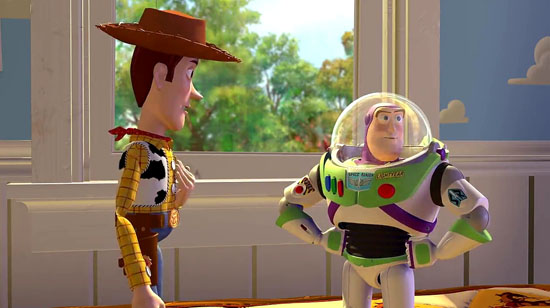
When Disney and Pixar’s Toy Story opened on November 22, 1995, critic Roger Ebert wrote in his review: “Watching the film, I felt like I was in at the dawn of a new era of movie animation, which draws on the best of cartoons and reality, creating a world somewhere in between, where space not only bends but snaps, crackles, and pops.”
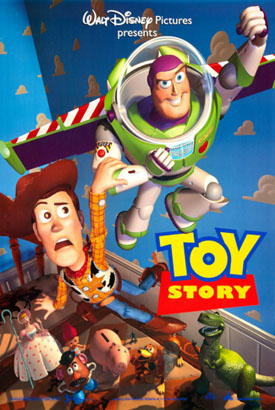 When Toy Story made its debut and astonished audiences, this sums up the consensus. Hard as it is to believe, the first computer-animated feature film that would usher in a new age for the medium is celebrating its 30th anniversary this month.
When Toy Story made its debut and astonished audiences, this sums up the consensus. Hard as it is to believe, the first computer-animated feature film that would usher in a new age for the medium is celebrating its 30th anniversary this month.
As everyone knows, the film tells the tale of two toys, Woody, the pull-string cowboy doll, and Buzz Lightyear, the sleek action figure, who both belong to young Andy. They start as adversaries, but when they find themselves in the grips of Sid, the toy-torturing kid, they must work together to rejoin Andy and all the other toys, like Mr. Potato Head, Bo Peep, Slinky Dog, Rex, and Hamm.
With that “buddy movie” story filled with humor and heart, Disney and Pixar’s relationship began, giving the world some of the most beloved animated characters and a film franchise that’s still going strong (Toy Story 5 hits theaters next year and its teaser trailer debuted this week.
To celebrate Toy Story’s thirtieth anniversary, what follows is insight from several of the artists who worked on the film:
The road to Toy Story was paved by Pixar’s Academy Award-winning short, Tin Toy (1988), which caught Disney’s attention. That short and, eventually, Toy Story grew out of director John Lasseter’s love of toys and collecting them. “I believe there is a connection between a love of toys and animation,” said Lasseter in a 1997 interview. “I found, at many animation studios, there are toys all over animators’ desks. To be an animator, a good character animator, I believe, there is a quality that can best be described as a child who’s never grown up. Because I think to be a good animator, you need a good child-like take on things. So much of animation is through observation and capturing the certain essences of things that people find familiar and showing it to them in ways that they’ve never seen before. There’s sort of this wide-eyed wonderment to things. I think, along with that, we all have this love of toys.”
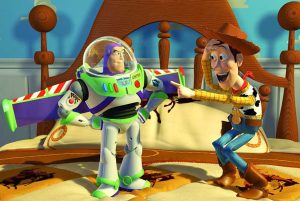 Like many animated films, the plot of Toy Story evolved and looked quite different in its early stages, as Lee Unkrich, an editor on the film who would go on to direct such blockbusters as Toy Story 3 (2010) and Coco (2017), told The Telegraph in a 2015 interview, discussing how different the initial story was: “This little, tiny toy gets left on the side of the road at a rest stop and goes on a road trip to find his owners, and he bumps into this hand-me-down ventriloquist doll who tries to help him. It was very convoluted, but we thought it was great at the time.”
Like many animated films, the plot of Toy Story evolved and looked quite different in its early stages, as Lee Unkrich, an editor on the film who would go on to direct such blockbusters as Toy Story 3 (2010) and Coco (2017), told The Telegraph in a 2015 interview, discussing how different the initial story was: “This little, tiny toy gets left on the side of the road at a rest stop and goes on a road trip to find his owners, and he bumps into this hand-me-down ventriloquist doll who tries to help him. It was very convoluted, but we thought it was great at the time.”
Also in that same article in The Telegraph, Pixar’s Senior Historian, Christine Freeman discussed how much the characters evolved during those early days of production: “There are so many different iterations of what Buzz and Woody might have looked like. In the archive, we have boxes of ‘Pointy Nose Woody,’ ‘Big Hair Buzz,’ ‘Scary Woody’…We have lots of artists’ good taste to thank for the film we saw.”
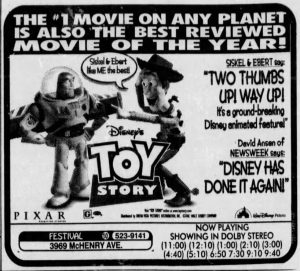 The voice cast for the film was, and is, stellar: Tom Hanks as Woody, Tim Allen as Buzz Lightyear, Annie Potts as Bo Peep, Wallace Shawn as Rex, John Ratzenberger (Pixar’s eventual “good luck charm”), as Hamm, Jim Varney, as Slinky Dog and Don Rickles, as Mr. Potato Head.
The voice cast for the film was, and is, stellar: Tom Hanks as Woody, Tim Allen as Buzz Lightyear, Annie Potts as Bo Peep, Wallace Shawn as Rex, John Ratzenberger (Pixar’s eventual “good luck charm”), as Hamm, Jim Varney, as Slinky Dog and Don Rickles, as Mr. Potato Head.
In a 1995 interview, Toy Story producer Bonnie Arnold discussed how much the actors informed the characters’ personalities. “A lot of what was read and how they read it helped the characters to evolve,” said Arnold of the voice cast. “Jim Varney, for instance, who’s doing the role of Slinky, initially, the character of Slinky was a little bit different, but as soon as we decided on Jim and we had Jim do a recording, Slinky became more of a hound dog, which of course fits Jim’s voice.”
In a 1999 interview, Unkrich discussed how the emotions and compelling plot found in Toy Story are the priority for Pixar over the technology: “We like to think of ourselves as storytellers and artists and not computer ‘techies.’ Story and character are really number one to us, and we’ve always tried to tailor the computer tools to aid in that process.”
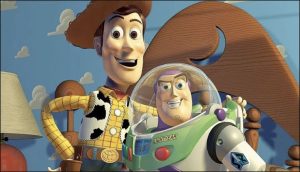 Glenn McQueen, an animator on Toy Story, who sadly passed away in 2002 (and would be the namesake for Cars’ Lightning McQueen) noted that the focus on story influenced how they train the team at Pixar: “If we hire an animator, the last thing I want is for that person to be spending their time worrying about technical issues,” said McQueen, in ’99. “They should only be worrying about the performance of their characters.”
Glenn McQueen, an animator on Toy Story, who sadly passed away in 2002 (and would be the namesake for Cars’ Lightning McQueen) noted that the focus on story influenced how they train the team at Pixar: “If we hire an animator, the last thing I want is for that person to be spending their time worrying about technical issues,” said McQueen, in ’99. “They should only be worrying about the performance of their characters.”
This, alongside the computer-generated wonder, is what has allowed Toy Story not just to endure, but to increase in popularity over the past thirty years, now passed on to others from that first generation who experienced the film in theaters.
Just before the film opened in 1995, producer Arnold noted: “The technology is amazing, absolutely amazing; I don’t think anyone can deny that. But that’s interesting for all of about five minutes. What will keep moviegoers in their seats is a good story – interesting characters, witty dialogue, and coming out of the picture learning something about yourself.”
